Making Caramel Cake

Many a little old lady has trodden caramel cake territory. Go there and you’ll find yourself getting in touch with your inner granny, the one with the heavy orthotic shoes, lace collar and tinge of blue in her hair. I did and I can tell you that it made me a better baker. However later I found myself complaining about street crime, the rudeness of pharmacy clerks and the scandal of mini skirts. It was a double-edged sword.
This is a sweet, rich layer cake that demands some time, though not more than any loving octogenarian would be willing to devote. So no excuses, K? Start by preparing three layer pans for baking. If you don’t have a third good one, a springform pan will fill in well here. Next, preheat your oven to 350 degrees Fahrenheit. That done, sift your cake flour into the bowl of a stand mixer.

Add in the sugar, salt and leavening.

Stir it all together on low, then add the soft butter. Stir on medium-low until it’s incorporated.
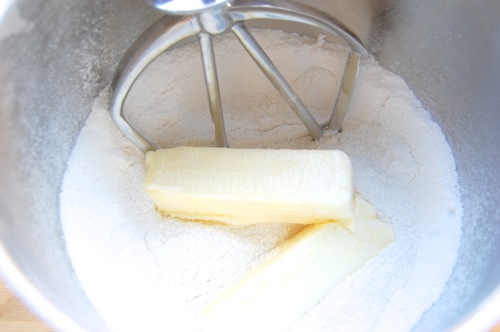
Next add 3/4 cup milk and beat on medium high for about 90 seconds.
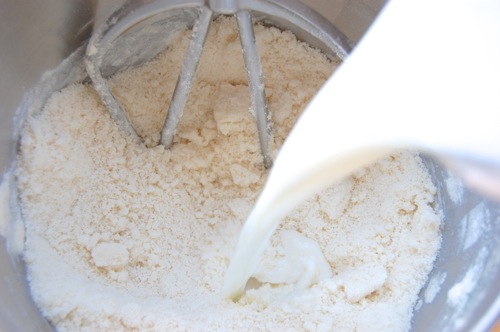
Scrape the bowl well.
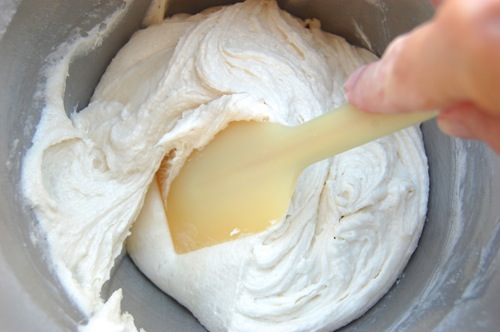
Combine the remaining milk with four of the egg whites and the vanilla and whisk it all together with a fork.
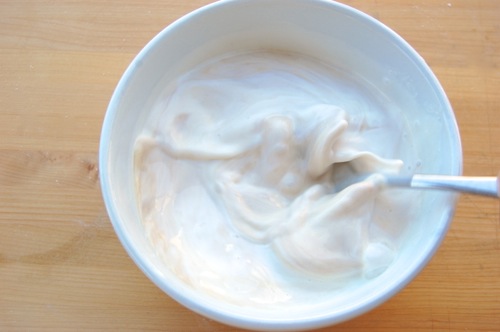
Pour in about a third. Beat the batter for about 10 seconds on medium high.
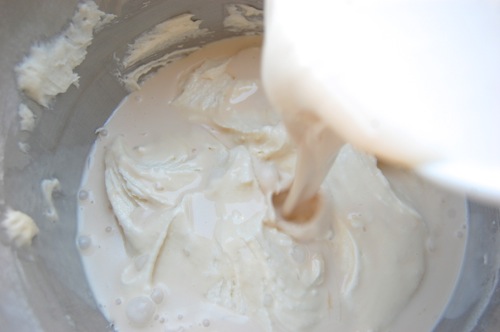
Scrape…add another third, beat, scrape, you get the idea.
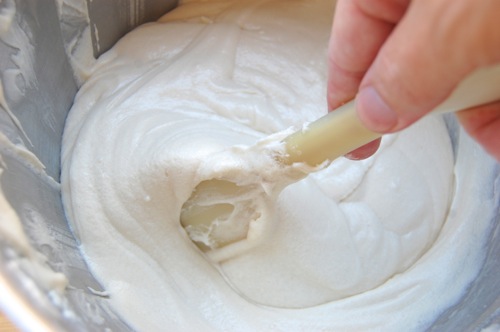
When the batter is homogenous scrape it into a large bowl.

Wash out the mixer bowl and add the egg whites. Don’t go crazy with the washing and such. The idea that even the tiniest speck of fat will ruin an egg foam is a myth. A hot rinse and a wipe-out are fine.
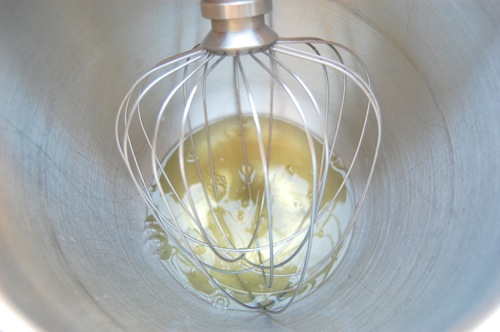
Whip the egg whites to soft peaks.
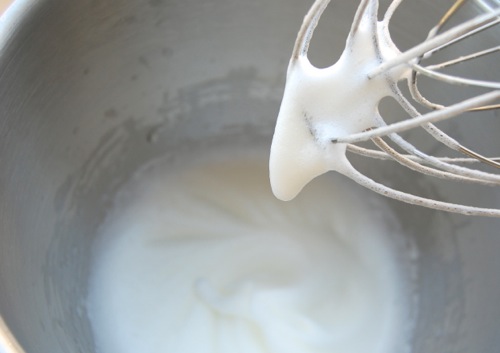
Fold them into the batter and you’re ready to roll.
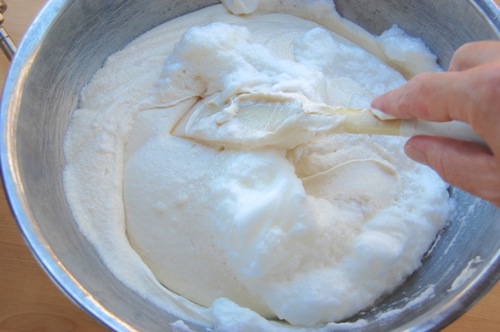
Scrape an equal amount of batter into the three pans. For those who are weighing, it’ll be about 21 ounces per.

Bake them about 30 minutes until they’re lightly browned and springy to the touch. Let them cool about 20 minutes…
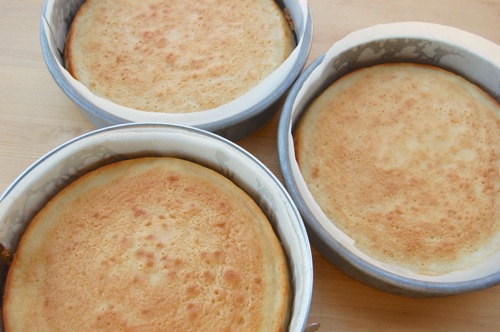
…then invert them onto a wire rack to cool completely, about another half hour. If I were going to do this a second time I’d put a sheet of parchment down since the top crust is a little sticky. The three layers can be frozen at this point for up to a couple of months. I generally like freezing layers for at least a short while since it makes it easier to trim and top them, a step I also recommend.
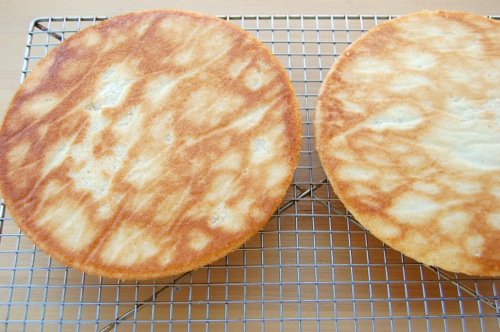
When you’re ready to assemble the cake, prepare your icing. Put one layer down on a cardboard round or cake circle and pour on about a cup and a half of icing. Spread it around a little, stack on the third layer and repeat.
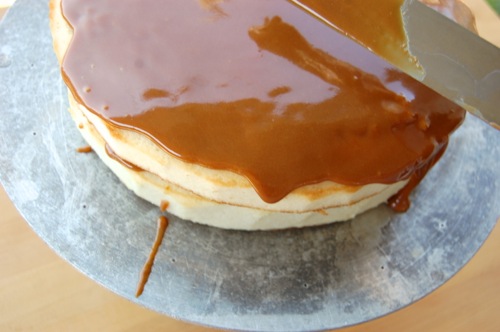
When all the layers are on, pour most of the rest of the thickened icing over the top (you’ll have extra). Had I been thinking clearly at this step I would have transferred it to a wire rack sitting a sheet pan, instead of just leaving it on my cake wheel here. Unfortunately I had a kindergartener and a third grader behind me just then, and they were arguing. I was too busy threatening them with a loss of Bugs Bunny privileges, and it got messy.

Promptly cover any bare patches before the icing firms too much.
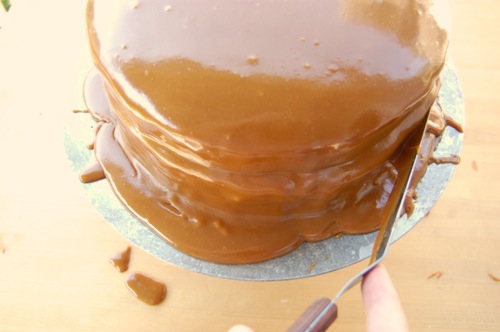
Allow the icing to firm at least half an hour (more is better) before slicing and serving. This is good stuff. Had parental discipline not prevented me last evening, I would have cut and photographed the cake right away while the icing laters were perfectly distinct. However I waited until this morning, at which point I saw that the icing had soaked into the cake a bit. It’s not a big deal, but it looked perfect last evening and as an uptight sorta guy, I prefer perfect when I can get it.
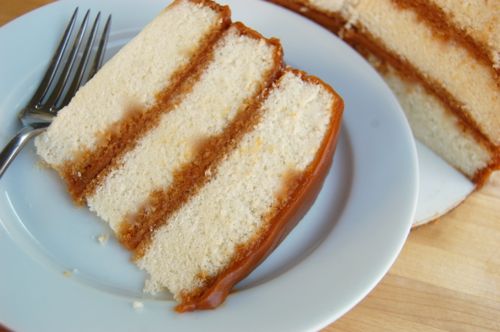
C’est la vie, eh? But it tasted just like it would have…had my grandma ever made it. But she didn’t. Oh, the wasted years.
I still think it looks awesome and I’m totally impressed that you can bake anything and parent at the same time. I used to kick my kid out of the kitchen. (Now I try to get her to help – but in her world that means scrape the excess batter out of the bottom of the bowl and complain about how long it takes for things to be assembled / bake / cool.)
I try not to bake when they’re around but yesterday I had no choice. Both of them are crazy about caramel so they wouldn’t leave me alone with the “is it done yet?” questions. It’s amazing I ever got through it! But thanks, K. I appreciate the email!
– Joe
Hi Joe,
Oh My Goodness! I think I heard a choir of angels singing when I saw the caramel all pooled around the cake.
So this is the one bowl mixing method right, because you cream the butter with the sugar and the flour first? In this case you also folded in egg whites, is that to add structure because the cake is 3 layers? Do the egg whites then also change the texture?
Can I have a piece? 😉
Eva
Hey Eva!
Well observed. This is indeed an augmented version of the “one bowl” a.k.a. “quick” a.k.a. “blending” method. The big giveaway is the blending of the fat with the dry ingredients at the beginning. The flour gets coated with fat which undermines gluten formation. In fact it does such a good job of undermining it that you have to take extra steps to agitate the batter so you at least get a little developed gluten. The end result is a crumb that’s very tender though not as high as a cake made via the creaming method.
As for the whipped egg whites, they provide a little oomph to help get the cake off the ground. I confess that when I changed the formulation I was a bit concerned that the cake would end up on the dry side. Less fat of course, but also the whipped egg whites tend to deliver a drier texture. Those fears were completely unfounded since the cake is extremely tender even so. I’m quite pleased with it. Try it and tell me what you think!
Happy weekend,
– Joe
In the most manly way…
That is a damn sexy cake.
That is all :p
It is covered in a rather form-fitting coat…leaves nothing to the imagination, that’s for sure.
Thanks Chris!
…ummm… I can’t figure out how to fit this into the entry about your Caramel Cake but, still, I feel pretty sure you and your readers would want to know about this: https://www.youtube.com/watch?v=Uz2Vnp5ZW4c&feature=player_embedded
I don’t know how to embed anything but it’s a Chinese video (perfectly clear without any language) about separating eggs. It’s neat and it’s effective and I bet you ain’t seen nuthin’ like it yet.
This looks so scrumptious! I love the way you write, so light and witty (yet informative). Not a simple feat! And the photography is as always bright and beautiful – even regardless the strategy on Bugs Bunny privileges. Thank you Joe!
Hah! Thanks so much, Tora! You made my day!
– Joe
Just a little decadent!
Just a touch! 😉
– Joe
Impressive, but the method will work only if the egg is very fresh.
HI DR! Thanks for the email. However I don’t think perfectly fresh eggs are necessary. Why do you say that?
– Joe
Hi Joe,
When an egg is fresh the white is tight and the yolk elastic, but not breakable. That is why you rcommand aging them for macarons, to reach likquid stage, right?
Hey DR!
Though it doesn’t make intuitive sense, older eggs are better for whipping in any situation. The low viscosity of the whites (thinness) makes it easier to beat air into them. So freshness actually works against you in most cake-making situations. Even when they’re simply being incorporated into the batter — as half of these are — freshness isn’t an issue since the proteins will remain intact even of the whites thin out.
Thanks for the great emails!
– Joe
I put 3 eggs out the fridge, it is winter Down Under and will wait for a week to try the trick. Will report the result. 🙂
OK, DR! I’ll be curious to know how it goes!
– Joe
Do you have the recipe for the caramel cake? Do you mix some egg whites with the milk or is that an error?
Thank you
Hi Ronnie!
The recipe scrolled off the page. Here it is:
http://joepastry.com/2012/caramel-cake-layers-2/
Let me know if you have any questions!
– Joe
Joe, I made this cake last night and it was outstanding. About two pieces in, my face went numb from all the sugar I had just eaten. Not that there’s anything wrong with that.
I do have a question, though. What’s the significance of getting the milk/caramel mixture to 238 degF before pulling it?
Also, I toasted up some pecans and mixed them into the caramel icing as it was cooling. That took the cake up to “11.”
Holy cow! That was a cake for the ages! Next time send some pictures please!
– Joe
Ask and you shall receive…
http://i665.photobucket.com/albums/vv13/whoopspat/25818971-1E81-42A2-8932-7A176465C20B-5908-0000049CD6363A05.jpg
http://i665.photobucket.com/albums/vv13/whoopspat/2AC19F66-D625-4BB5-A111-C2B8A3C74E56-5908-0000049CDBDAD76D.jpg
Obviously nothing says “elegance” like serving a cake on a foiled cookie sheet, haha. I don’t own any cake-specific serving stuff. One of these days, though…
Also, I noticed there’s quite a bit more “crumble” with my cake in the cut pic vs. yours. Is that the result of sloppy knife work by me or did I do something incorrectly during the cake making part?
Wonderful! Thanks so much, Pat! I wish I were there for some. And no, you didn’t do any wrong with the cake. It’s moist and crumbly as a rule. Sometimes I chill a cake that’s this rich and tender so it slices a bit more cleanly. However I don’t think it make it taste any better! 😉
Thanks for the everything!
– Joe
Hey Pat!
Yeah, ya gotta be careful with this stuff…it’ll put you in a coma! 😉
As for the temperature, it’s all about the moisture content of the caramel. 238 is simply the point at which the right amount of moisture has been cooked out for the icing to work. Hope that helps!
– Joe